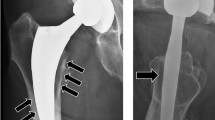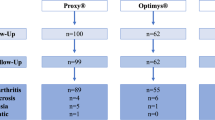Abstract
The Adaptiva custom-made stem is a hip stem anchored by fit and fill press-fit into the proximal femur and manufacture is based on computed tomography (CT) scanning. Its concept was developed for primary and revision hip arthroplasty in younger patients in our clinic. We present the advantages and the disadvantages of the system. After 66 months 98.9% of the patients are satisfied with the surgical outcome; 86% attained very good and 9% good results according to the Merle d’Aubigné score. Despite good clinical results and a high satisfaction rate, we stopped using this stem because we do not see any advantages in comparison with standard implants and feel that the price for a custom-made stem for primary hip arthroplasty is too high.
Résumé
La tige prothétique Adaptiva est une tige sur mesure à ancrage sans ciment par ajustage à partir des données de scanner. Ce concept a été développé dans notre Centre pour les prothèses primaires et de révision chez les sujets jeunes. A 66 mois , 98,9 % des patients sont satisfaits de l’évolution, avec selon la cotation de Merle d’Aubigné 86% de très bons et 9% de bons résultats. Malgré les bons résultats cliniques et le haut degré de satisfaction nous avons arrêté la fabrication de cette tige car nous ne voyons pas d’avantage en comparaison d’implants standards et le prix d’une prothèse sur mesure pour une arthroplastie primaire est trop élevé.




Similar content being viewed by others
References
Arabmotlagh M, Hennings T, Rittmeister M (2003) Femoral periprosthetic bone remodeling to the proximal femur after implantation of custom made anatomic and standard straight stem hip prostheses. Z Orthop Ihre Grenzgeb 141(5):519–525
Aldinger G, Weipert A (1991) 3D-based production of hip joints: the Aldinger system. Radiologe 31:474–480
Aldinger P, Thomsen M, Mau H, Ewerbeck V, Breusch S (2003) Cementless Spotorno tapered titanium stems: excellent 10-15-year survival in 141 young patients. Acta Orthop Scand 74(3):253–258
Arcq M (1973) Die periartikuläre Ossifikation—eine Komplikation der Totalendoprothese des Hüftgelenkes. Arch Orthop Trauma Surg 77(2):108–131
Chang PB, Robie BH, Bartel DL (1999) Preclinical cost analysis of orthopaedic implants: a custom versus standard cementless femoral component for revision total hip arthroplasty. J Biomech 32(12):1309–1318
Collis DK (1988) Long-term results of an individual surgeon. Orthop Clin North Am 19(3):541–550
Cuckler J (2005) Limb length and stability in total hip replacement. Orthopedics 28(9):951–953
Eingartner C, Heigele T, Dieter J, Winter E, Weise K (2003) Long-term results with the BiCONTACT system—aspects to investigate and to learn from. Int Orthop 27(Suppl 1):S11–S15
Götze C, Steens W, Vieth V, Poremba C, Claes L, Steinbeck J (2002) Primary stability in cementless femoral stems: custom-made versus conventional femoral prosthesis. Clin Biomech 17(4):267–273
Goldstein W, Gordon A, Branson J (2005) Leg length inequality in total hip arthroplasty. Orthopedics 28(9):1037–1040
Gruen TA, McNeice GM, Amstutz HC (1979) Modes of failure of cemented stem-type femoral components. Clin Orthop 141:17–27
Hua J, Walker PS (1994) Relative motion of hip stems under load. An in vitro study of symmetrical, asymmetrical, and custom asymmetrical designs. J Bone Joint Surg Am 76(1):95–103
Hua J, Walker PS (1995) Closeness of fit of uncemented stems improves the strain distribution in the femur. J Orthop Res 13(3):339–346
Küsswetter W, Sell S (1993) Mittelfristige Ergebnisse mit dem zementfreien individuellen Femurersatz. Z Orthop 131:553–557
Kutschera H-P, Eyb R, Schartelmüller T, Toma C, Zweymüller K (1993) Das zementfreie Zweymüller Hüft-System. Ergebnisse einer 5-Jahres-Nachuntersuchung. Z Orthop 131:513–517
Martini F (2001) Wertigkeit osteodensitometrischer Messungen unter besonderer Berücksichtigung des Verlaufs der periprothetischen Knochendichte der Individualendoprothesen Evolution-K und Adaptiva in Korrelation zur kortikalen Anlagefläche. Habilitationsschrift, Eberhard-Karls-Universität, Tübingen
Martini F, Lebherz C, Mayer F, Leichtle U, Kremling E, Sell S (2000) Precision of the measurements of periprosthetic bone mineral density in hips with a custom-made femoral stem. J Bone Joint Surg Br 82(7):1065–1071
Reize P, Giehl J, Schanbacher J, Bronner R (2002) Clinical and radiological results of individual hip stems of the type Adaptiva without cement. Z Orthop Ihre Grenzgeb 140(3):304–309
Rittmeister M, Eisenbeis K, Hanusek S, Yanik-Karaca Z, Starker M, Arabmotlagh M (2004) Assessment of implant position of CTX-custom-made stems with EBRA-FCA in 107 cases of total joint replacement. Z Orthop Ihre Grenzgeb 142(6):659–665
Robertson DD, Walker PS, Granholm JW, Nelson PC, Weiss PJ, Fishman EK, Magid D (1987) Design of custom hip stem prostheses using three-dimensional CT modeling. J Comput Assist Tomogr 11(5):804–809
Sharp DJ, Porter KM (1985) The Charnley total hip arthroplasty in patients under 40. Clin Orthop 201:51–56
Traulsen F, Hassenpflug J, Hahne H (2001) Long-term results with cement-free total hip prostheses (Zweymüller). Z Orthop Ihre Grenzgeb 139(3):206–211
Wettstein M, Mouhsine E, Argenson JN, Rubin PJ, Aubaniac JM, Leyvraz PF (2005) Three-dimensional computed cementless custom femoral stems in young patients: midterm follow-up. Clin Orthop Relat Res 437:169–175
Wick M, Lester D (2004) Radiological changes in second- and third-generation Zweymüller stems. J Bone Jt Surg Br 86(8):1108–1114
Author information
Authors and Affiliations
Corresponding author
Rights and permissions
About this article
Cite this article
Reize, P.K., Wülker, N. The Adaptiva custom-made stem—our reasons for not using it anymore. International Orthopaedics (SICOT) 31, 217–222 (2007). https://doi.org/10.1007/s00264-006-0160-5
Received:
Revised:
Accepted:
Published:
Issue Date:
DOI: https://doi.org/10.1007/s00264-006-0160-5




